



Dobbs Weir is both a weir in Hoddesdon, Hertfordshire and an area of Roydon, Essex in England on the River Lea. It is well known for angling, outdoor beauty and watersports. It is overlooked by the Fish and Eels pub. [1]




Dobbs Weir is both a weir in Hoddesdon, Hertfordshire and an area of Roydon, Essex in England on the River Lea. It is well known for angling, outdoor beauty and watersports. It is overlooked by the Fish and Eels pub. [1]
The weir is a popular fishery. In 2003, the then record Chub weighing 8.8 pounds was caught by Tim Archer. [2] The fishery is owned by the Lee Valley Regional Park Authority and is currently (2013) controlled by the partnership of Ware Angling Club and Hertford Angling Club forming a part of the Towpath Fishery. Day tickets are available on the bank. Season tickets are available by joining one of the controlling clubs.
Dobbs Weir has had a long history serving the watersports community, as the sluice gates after the v-drops could be changed according to the flow of the water. Especially in winter months after heavy rain the weir could be changed into a formidable feature used for whitewater training or playboating.
Since August 2003, when British Waterways padlocked the sluice gates, watersports enthusiasts have been forced to go elsewhere, as the site has been deemed unsafe and requires approximately £25,000 for the weir to be repaired.

The Lee Navigation is a canalised river incorporating the River Lea. It flows from Hertford Castle Weir to the River Thames at Bow Creek; its first lock is Hertford Lock and its last Bow Locks.

The River Rother, a waterway in the northern midlands of England, gives its name to the town of Rotherham and to the Rother Valley parliamentary constituency. It rises in Pilsley in Derbyshire and flows in a generally northwards direction through the centre of Chesterfield, where it feeds the Chesterfield Canal, and on through the Rother Valley Country Park and several districts of Sheffield before joining the River Don at Rotherham in Yorkshire. Historically, it powered mills, mainly corn or flour mills, but most had ceased to operate by the early 20th century, and few of the mill buildings survive.

Stanborough Park, also referred to as Stanborough Lakes is a 126-acre (0.51 km2) park in Welwyn Garden City, Hertfordshire, England.

Coarse fishing is a phrase commonly used in Britain and Ireland. It refers to the angling for rough fish, which are fish species considered undesirable as food or game fish. Freshwater game fish are all salmonids, particularly salmon, trout and char. Generally, coarse fish are freshwater fish that are not salmonids, though there is often disagreement over whether grayling should be classified as a game fish or a coarse fish.

Hertford Castle Weir is a weir located in Hertford near to Hertford Castle and next to Hertford Theatre.

The Lea Valley Walk is a 50-mile (80 km) long-distance path located between Leagrave, the source of the River Lea near Luton, and the Thames, at Limehouse Basin, Limehouse, east London. From its source much of the walk is rural. At Hertford the path follows the towpath of the River Lee Navigation, and it becomes increasingly urbanised as it approaches London. The walk was opened in 1993 and is waymarked throughout using a swan logo.

The Small River Lea is a minor tributary of the River Lea, which flows through the Lee Valley Park between Cheshunt and Enfield Lock. It forms part of the Turnford and Cheshunt Pits Site of Special Scientific Interest (SSSI) as it flows through the River Lee Country Park.

Feildes Weir is a weir on the River Lea located in Hoddesdon, Hertfordshire at the confluence of the River Lea and River Stort. The weir marks the start of the Lower Lee. A channel of the man-made River Lee Flood Relief Channel is incorporated into the weir.

Carthagena Weir is a weir located at Broxbourne on the River Lea. The well oxygenated water with depths ranging to over 16 ft, makes it an ideal environment for coarse fish including the common barbel.
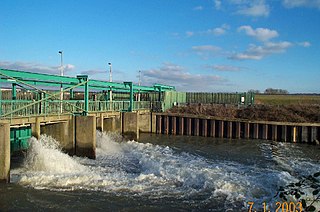
The Lee Flood Relief Channel (FRC) is located in the Lea Valley and flows between Ware, Hertfordshire, and Stratford, east London. Work started on the channel in 1947 following major flooding and it was fully operational by 1976. The channel incorporates existing watercourses, lakes, and new channels. Water from the channel feeds the Lee Valley Reservoir Chain.
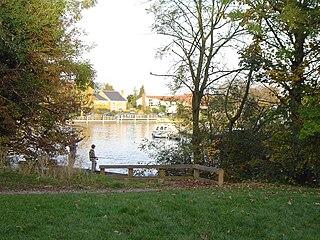
Penton Hook Island is a mainly wooded former peninsula created into a series of three weir-divided islands in the River Thames in England, so created in river modifications since 1815 with a navigable lock and weir stream channel to form meander cutoffs. It has a lock and weirs that are the divide between the Laleham Reach, above Chertsey Lock and Staines Reach, above Penton Hook Lock.

Fishers Green is a settlement in the parish of Waltham Abbey in Essex, England, lying 1 mile (1.6 km) to the north of the main built-up area. It lies on the flood plain of the River Lea.
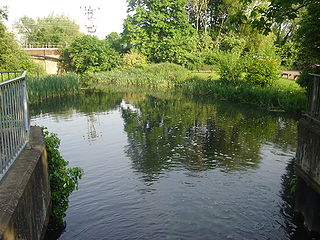
Broxbourne Mill is located at the Old Mill and Meadows Site Lee Valley Park, Broxbourne, Hertfordshire.

The Nene Whitewater Centre was the UK's first pumped artificial whitewater course. It is located on the River Nene in Northampton.

The Coppermill Stream is a short waterway near Walthamstow in the Lea Valley. Originally a minor tributary of the River Lea, the approximately 2-mile (3.2 km) long stream is now used as an aqueduct to transport water from the reservoirs in the Lea Valley to Coppermills Water Treatment Works. The stream is part of a Site of Metropolitan Importance.

Dobbs Weir Lock is a lock on the River Lee Navigation near Hoddesdon.

Three Mills Wall River Weir is a weir on the Bow Back Rivers, in Mill Meads in the London Borough of Newham, England, near to Three Mills. It was built in 2009, when the Bow Back Rivers were refurbished to make them a key feature of the Queen Elizabeth Olympic Park, and maintains water levels through much of the park in conjunction with the Three Mills Lock and sluice on the Prescott Channel.
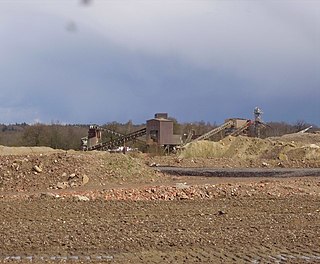
The Yateley Complex is a working gravel pit and a series of fishing lakes at Yateley, Hampshire, England, operated by CEMEX, the world's largest building materials supplier. The fishing side of the facility is under the management of CEMEX Angling, a subsidiary of the main company. CEMEX Angling operates 11 lakes at the site, which includes part of the River Blackwater and is stocked with a variety of fish. Around 5000 anglers a year visit the complex, which was also home to Heather the Leather, described as "Britain's most famous fish". In addition to angling use, some of the gravel pits have been restored as sports pitches and some were nominated as potential allotment sites.
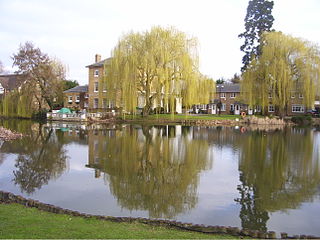
The River Lynch, also known as the Lynch Brook, is a minor tributary of the River Lea in Hoddesdon, Hertfordshire, England.
Kirkthorpe hydro is a hydroelectric generating plant located on the River Calder at Kirkthorpe Weir, 4 miles (6.4 km) east of the City of Wakefield in West Yorkshire, England. The plant was opened in 2017 and expects to be generating electricity for 100 years. Kirkthorpe Weir is the highest industrial weir in Yorkshire and has prevented fish passing upstream to spawn; the new hydro project has a fish pass built into it.